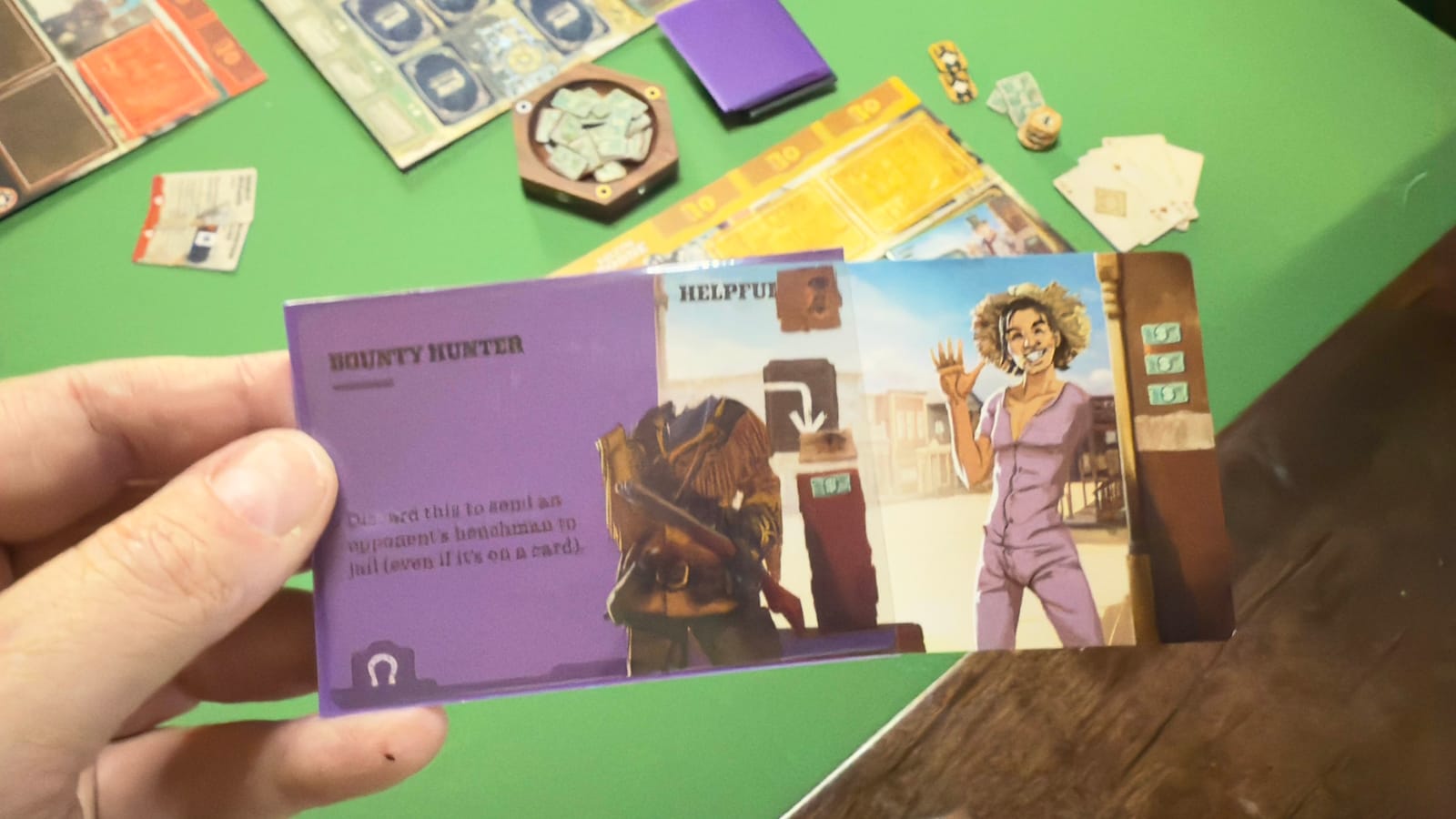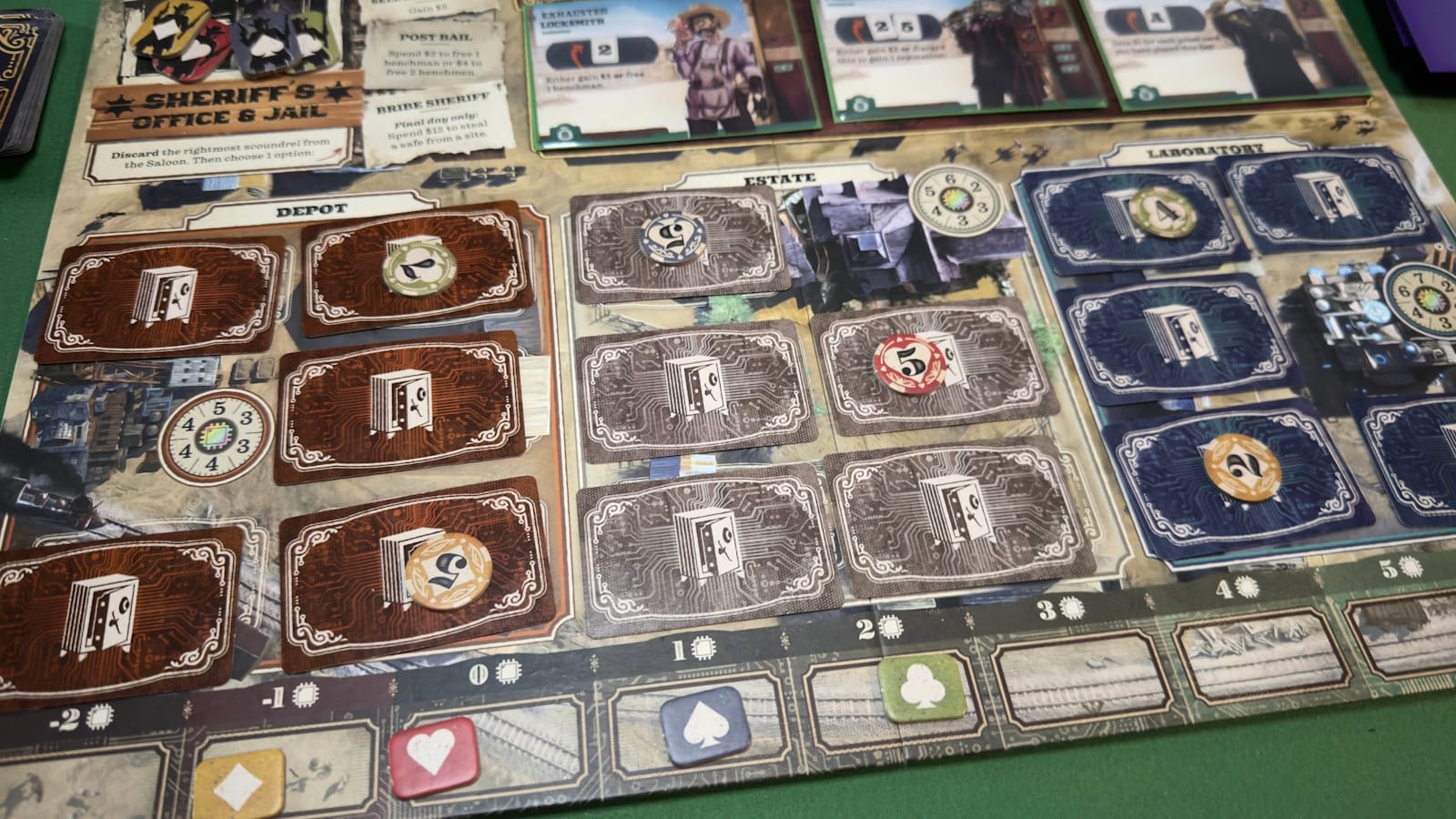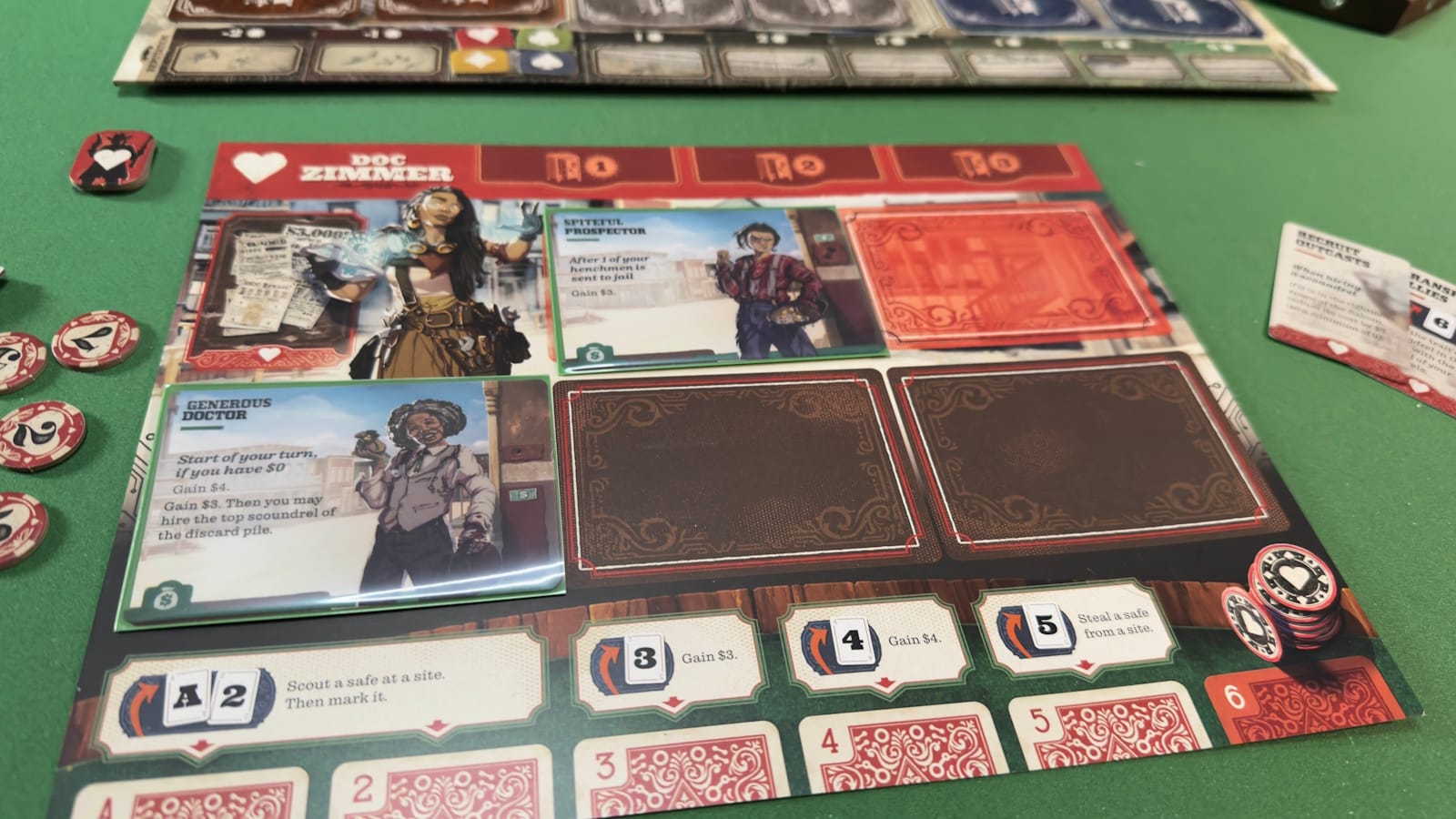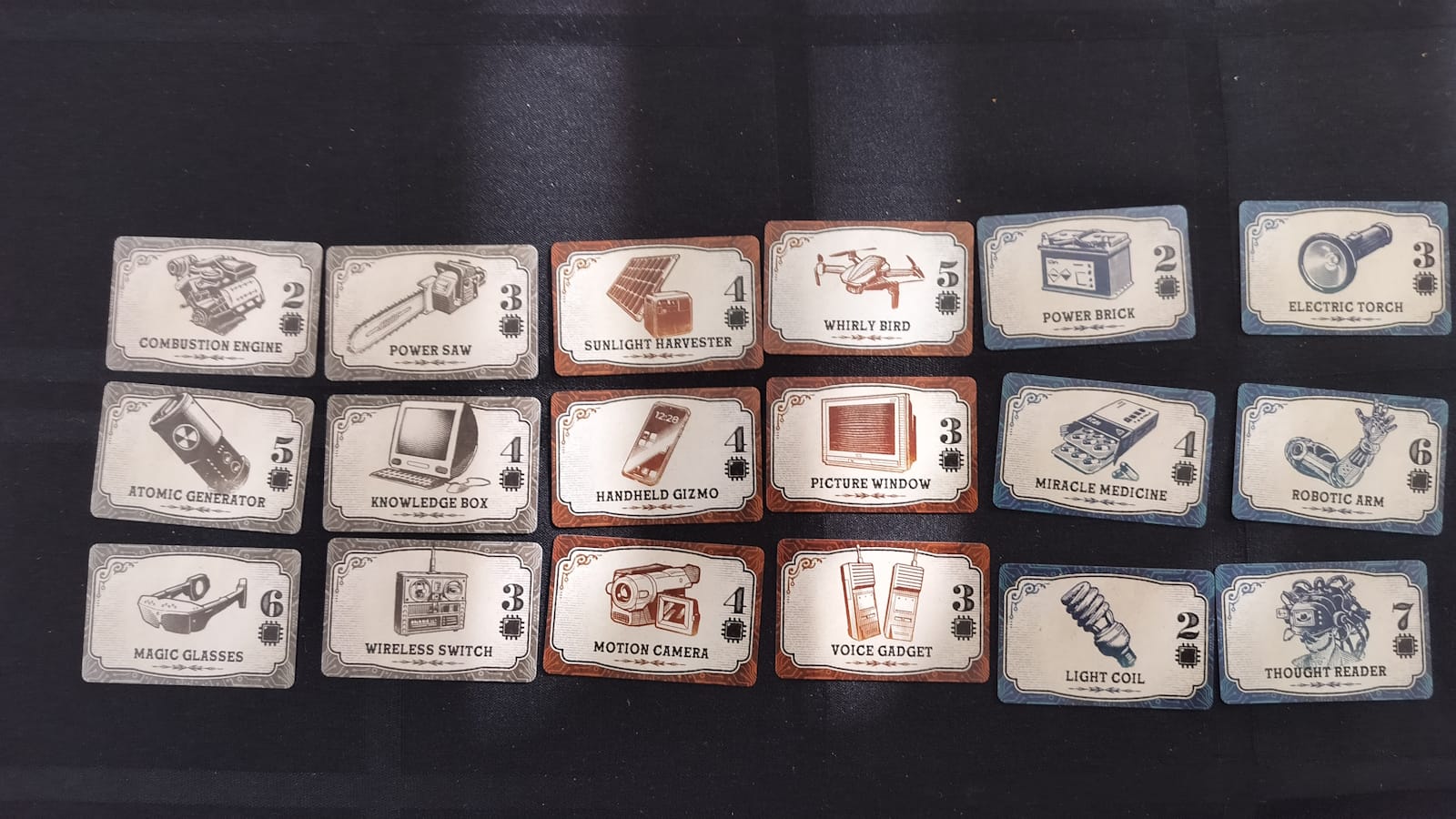
In the far future, who knows how far, someone figured out time travel, and went back to the 1800s to see what the Wild West was really like. And they brought all of the modern comforts: phones, tablets, robots, and portable nuclear reactors. No one really knows what the Traveller was up to, but when he left, he left it all behind. Those native to that era, leaders of their own gangs of scoundrels, are trying to grab as much of that tech as possible before the Feds show up and lock it all away.

3000 Scoundrels designed by Corey Konieczka and published by Unexpected Games is an engine building game with bluffing mechanics. Players play as leaders of a gang of scoundrels in the Old West settlement the Traveler so recently left. Their goal is to track down the best, most powerful technology for themselves within 3 days. After those 3 days, the Feds will sweep the area, loading everything leftover on a train to Washington, never to be seen again.
Each turn, players will utilize one of six actions. To play an action, they need to play one of their 4 poker cards face down on the action, meaning that once the action is used, it can’t be used again until the next round. Both the cards and action locations have a number on them. Importantly, the cards and numbers you play them on do not have to be the same. However, each time you play, other players have an option to send a henchman to keep you honest. If a henchman is put on a card that doesn’t match the action, then the lying player loses reputation, and the catcher gains a reputation. If they’re not lying, then the henchman gets sent to jail for the trouble. Each reputation gives a point, though it’s possible to lose points from reputation as well. An important wrinkle here is that you cycle through 7 cards, one being a 0, which can only ever be used to bluff, so no one gets out completely honest.

There are a few different actions that can be taken. The Ace and 2 give the ability to scout a safe, while the 3 and 4 give money (3 dollars and 4 dollars, respectively). The 5 takes a safe, and the 6 does nothing (on its own). See, each turn players will be able to use the action chosen to activate their scoundrels.
Scoundrels are like paper-dolls, with one card providing their face, personality, left hand, and the ability trigger of the scoundrel. The other card is transparent, providing the character with clothing fitting of their job and the left hand of the character, as well as the scoundrel’s ability. Both cards modify the cost of the scoundrel. The game’s name comes from this mixture, as with 50 traits and 60 jobs, there are a total of 3000 possible scoundrel combinations, though many are simply unlikely due to the way the decks are set up at the beginning of the game.

Each scoundrel typically activates when a specific action is used, as indicated by the number on the trait portion of the card. There are more traits that trigger off of 6, though some traits allow cards to activate when another card activates, leading to interesting combos. In fact, the overall combination of cards can result in all kinds of weird things. Some card combos are downright overpowered, while others are almost useless. It really makes the scoundrels feel like characters in this oddball town instead of just pieces of an engine to use. Of course, if there is a particularly powerful triggered ability a player uses, they’ll be extremely incentivized to bluff to use it. After all, it’s not possible to always get a number a player might want.

The other half of the bluffing mechanics in 3000 Scoundrels comes from the best way to get points: Safes. Each day, players can steal (and keep) up to 1 safe. These safes are kept face down on the board until either scouted or stolen, and each are worth wildly varying results. When scouting a safe, players are required to place one of their numbered poker chips on it. They can either lie about the safe, maybe drawing opponents away or getting them to steal a dud piece of tech, or they can tell the truth, which adds 1 additional point to the final score of that tech. This risk and reward means that players can tell the truth to be greedy and boost their score, but have to contend with the possibility of other players taking the safe out from under them.

This means that while clever play is good for building an engine, every method of making points comes down to bluffing, and sussing out bluffs, either in the action selection and henchmen or when marking and stealing safes. Is it worth trying to grab something marked with a 5 point token, since it might be worth 6 if that’s accurate? It’s probably more likely that it’s worth 2 points, and your opponent wants you to waste your turn! Players also have the option of dumping one of their previous safes for a better one later in the game, if they find the means to steal more than one safe in a single day.
This does lead to a problem with the game. The old adage is “better lucky than good”, and this game is proof. If you find a high value safe in your first scout, for example, and take it on the very next action, you might have a dominating score lead through the entire game. A score lead that no one else is aware of, so they can’t work to prevent your victory. Then again, there is almost always an opportunity for someone else to snag a safe between scouts until very late in the game when the best safes have already been picked clean.

However, the luck aspect of the game is just part and parcel for a game themed on gambling and the old west. The game is still more than worth playing just to see what the heck the scoundrel deck will spit out next. A grizzled man in a maid uniform? Sure! A seductress head-in-a-jar? Why not!
The art is perfect for the theme. A mixture of high technology with wild west aesthetics. Cowboys with cybernetic arms, clockwork fortune tellers powered by advanced computers, and nuclear powered butlers. On top of that, the technology in the safes is also amusingly named. Something that looks like Tylenol is called “miracle medicine”. A remote control is called a “wireless switch”.

The aesthetic, the mix and match paper doll cards, and the bluffing mechanics all come together to make a delicious soup that makes 3000 Scoundrels sing. It’s a great time, every time.
3000 Scoundrels
Great
A time traveling wild west board game with mix and match card creation to power its engine building. Each game will see only a small subset of the 3000 possible Scoundrels, but the base bluffing mechanics allow for skill expression in the chaotic game states.
Pros
- Amazing aesthetic with a knockout theme. Anachronistic technology plus the wild west!
- Mix and match scoundrels leads to literal thousands of possibilities, deep replayability.
- Fairly deep bluffing game
Cons
- Despite the bluffing game, it’s always possible to luck into the highest possible points without needing to build a good engine.
- Some scoundrels wind up being either very powerful, or just plain useless.
This review is based on a retail copy provided by the publisher.
